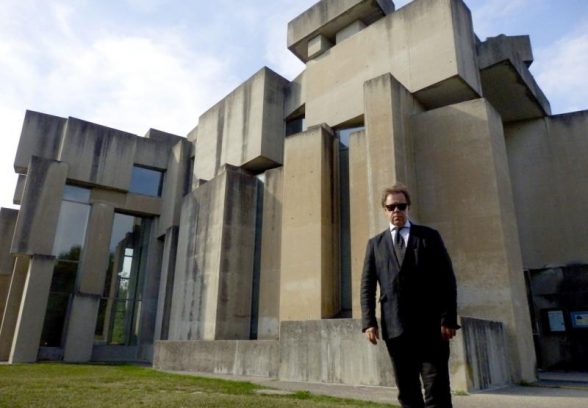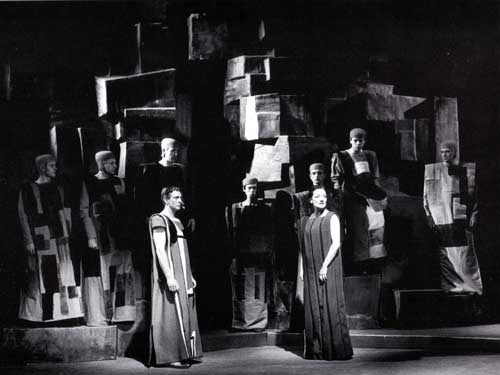This website uses cookies
This website uses cookies to enable it to function properly and to analyse how the website is used. Please click 'Close' to accept and continue using the website.




I was struck by one building which featured in Jonathan Meades’ recent (and much discussed) Bunkers, Brutalism and Bloodymindedness: Concrete Poetry –the Wotruba Church on the outskirts of Viennna, which I didn’t know about and have never visited . I think it even got the distinction of being identified on screen, (mostly viewers were just left to guess where buildings were).
So is this an example of Brutalism? Or a Brutalist precursor? I was intrigued and investigated further. The church was built between 1974 and 1976 to designs begun in 1967 by Austrian artist and sculptor Fritz Wotruba (1907-1975), who collaborated with architect Fritz Gerhard Mayer (about whom I could find out very little).
It looks the part of a Brutalist monument, as it is made from 152 cuboid blocks of unpainted precast concrete, stacked together, with openings between some of them glazed to form windows. I’ve got hold of the catalogue to an exhibition of his work held in 1968 as part of Edinburgh Festival (it was at the Royal Scottish Museum Chambers Street , now the National Museum of Scotland, and in the East Princes Street Gardens). In it he writes that he was stimulated “by functional silos and hangers, in conjunction with the forms of the often unlovely surrounding landscape…the practical layout of a harbour or factory”…so that seemed promising.
This catalogue also gives some idea of how well known his work was in the UK, he notes that in “In May [1951] I was in London, invited by the Arts Council; a visit to Henry Moore at Much Hadham. Herbert Read delivered a lecture on my work at the Institute of Contemporary Arts”. There was also a work by him in Battersea Park that year (presumably as part of the Festival of Britain). He was included in the 1948 and 1952 Venice Biennales, had an exhibition at the Hanover Gallery London in 1950. He was included in an Arts Council show of Austrian painting and sculpture exhibition in 1960and in 1966 the Marlborough galley showed his reliefs and sculptures. The picture top right shows a stage set for a production of Oedipus Rex at the Burgtheater, Vienna in 1960, but I donlt know if that was published here.
Wotruba began his career as a figurative artist, and his work only started to become abstracted after the war (which he spent tin Switzerland) . The image bottom left gives some idea of what his work was like in the mid-60s—and I don’t think it has much to do with Brutalism at all. The church too seems more expressionist than Brutalist to me—(and looks dramatic due to its isolated location, one suggestion is that Chatres Cathedral was the inspiration—perhaps in terms of prominence on the skyline?). Perhaps the most sensible thing to say is that there is still a lot of work to be done about just what Brutalism is.
However, I was fascinated by the fact (gleaned from Wikipedia) that as a student Wotruba “ received a stipend by the Vienna Society of Modern Art, the Austrian Chamber of Labor and the municipality of Vienna – which was obtained for him by the ministrations of Anna Mahler, who was his pupil & lover.” Anna Mahler (1904 – 1988) was the daughter of composer Gustav Mahler and Alma Mahler, but Anna was having an affair with Walter Gropius before Gustav Mahler died in 1911. After a further affair with Oskar Kokoschka ,Alma married Gropius which “provided some semblance of family life during Anna’s adolescence”. Could this be a relevant link?
Probably not, and probably not much of a stable family life either—by 1918 Alma had a child by the man who was to become her third husband. Incidentally (and more or less irrelevantly) Anna Mahler was married five times. Twice before she met Wotruba—husband one, when she was sixteen, was a “rising young conductor, Rupert Koller”, then husband two four years later was composer Ernst Krenek . Post –Wotruba in 1929 husband three was publisher Paul Zsolnay. In April 1939 she was living in Hampstead (who did she know there?). In 1943 she married the conductor Anatole Fistoulari and moved to California. Final husband five, c.1970, was Albrecht Joseph, a Hollywood film editor and writer of screenplays. At some point she returned to London alone and finally was living in Spoleto in Italy in 1969. What a life. Not clear how much sculpture she fitted in.

Become a C20 member today and help save our modern design heritage.
Comments